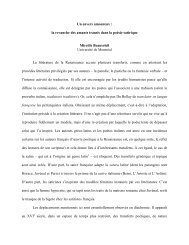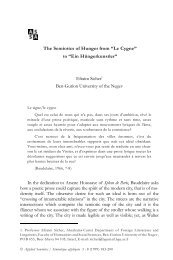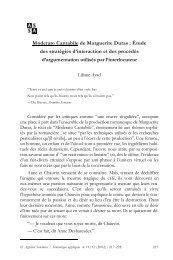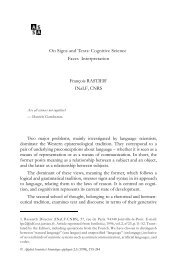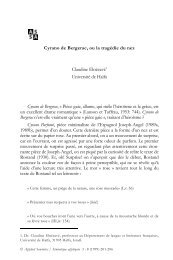“Beannacht libh, cried Miss Ivors” Translating James Joyce: Culture ...
“Beannacht libh, cried Miss Ivors” Translating James Joyce: Culture ...
“Beannacht libh, cried Miss Ivors” Translating James Joyce: Culture ...
You also want an ePaper? Increase the reach of your titles
YUMPU automatically turns print PDFs into web optimized ePapers that Google loves.
sought to determine what happens when a translator engages in the act of translation, when s/he<br />
replaces “textual material in one language by equivalent material in another language” 2 , and to<br />
assess the nature of the existing manipulation.<br />
The goal of this paper is to analyze how translators translate and thus, like the contributors<br />
to Hermans’ collection, assess the nature of translators’ manipulation. Indeed, by producing a<br />
comparative analysis of two French translations of <strong>James</strong> <strong>Joyce</strong>’s short story “The Dead”, I hope<br />
to discover trends in the act of translation. This practice is complex and encompasses a multitude<br />
of linguistic and extra-linguistic features. It therefore seems appropriate to focus on only one of<br />
them. Although translating is primarily a linguistic act, I will concentrate on an extra-linguistic<br />
feature of translation: the cultural dimension of this practice. The refined aim of this research is<br />
therefore to show how translators react to the cultural elements present in the source text, the<br />
material they have to translate, and how they convey their meanings into the target text, the<br />
translation itself. It will thus prove useful to compare how two French translators translated the<br />
Irish culture-specific items (CSIs), such as place names, historical references or idioms, of<br />
<strong>Joyce</strong>’s text, and to determine what their translation choices imply. On a technical level, I will try<br />
to determine which translating tools are used and how they reconstitute the cultural notion of the<br />
source text in the target text. On a semantic level, I will examine the degree of comprehension<br />
conveyed to the reader of the translation. Finally, on a strategic level, I will assess whether the<br />
translators’ choices are systematic within each of their texts. These are the three areas which<br />
motivate this comparative analysis. In short, “How is culture translated in practice?” or “Is<br />
culture translatable?”<br />
2





